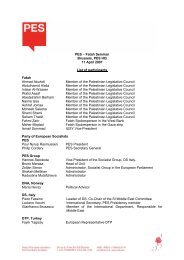Hedge funds and Private Equity - PES
Hedge funds and Private Equity - PES
Hedge funds and Private Equity - PES
Create successful ePaper yourself
Turn your PDF publications into a flip-book with our unique Google optimized e-Paper software.
time peak in 2005.” It is important to note the fact that correlations are rising not only within some<br />
strategies, but also among strategies, raising concerns that some triggering event could lead to<br />
highly correlated exits. Furthermore, the ECB has stressed that “… the levels reached in late<br />
2005 exceeded those that prevailed just before the near-collapse of the LTCM …” 70 .<br />
Medians of pair wise correlation coefficients<br />
of monthly hedge fund returns within strategies<br />
(Jan. 1995-Dec. 2005, monthly net of all returns in USD)<br />
0.8 0.8<br />
0.7 0.7<br />
0.6 0.6<br />
0.5 0.5<br />
0.4 0.4<br />
0.3 0.3<br />
0.2 0.2<br />
0.1 0.1<br />
0<br />
1995 1996 1997 1998 1999 2000 2001 2002 2003 2004 2005<br />
Sources: ECB Financial Stability Review, June 2006. (Numbers in parentheses after strategy<br />
indicate the share of total capital under management (excluding FOHFs) at the end of 2005.)<br />
There may be a number of reasons for high correlations. In the case of the LTCM crisis (see box<br />
1) many of the virtual, statistical models used by hedge <strong>funds</strong> <strong>and</strong> other players in financial<br />
markets led to the same kind of behaviour. In the case of LTCM it also seems as if the brokers,<br />
who received order flow information through their dealings with LTCM, took similar positions<br />
alongside their client. In the more recent case of the hedge fund Amaranth (see box 2), the<br />
reason for its default does not appear to lie especially in excess of leverage but in an unsatisfactory<br />
management approach, which underestimated the correlation among different bets <strong>and</strong><br />
the problematic concentration on a single thin market like the market for natural gas. Amaranth’s<br />
position represented a significant share of the whole market. Consequently, it was difficult to<br />
unwind the fund’s portfolio when things begun to get worse.<br />
Despite the increasing correlations, the more recent default of the hedge fund Amaranth did not<br />
appear to have threatened or even influenced financial market stability (see box 2). Thus, there<br />
has been an absolute absence of contagion spreads over the other financial markets: No volatility<br />
spikes were registered during September 2006, neither on the stock markets, nor on the bond<br />
markets. Furthermore, the commodity market itself did not show any sign of fear as the ordinary<br />
price behaviour of the CRB index in September 2006 testifies. Nonetheless the absence of<br />
contagion spreads in the Amaranth case is no assurance that hedge <strong>funds</strong> have become any<br />
more robust. One of several important differences to the LTCM crisis of 1998 was the situation<br />
of global financial markets. In 1998 they were under extreme stress in the aftermath of the<br />
Russian crisis. In 2006 they were awash with cash after many years of loose monetary policy.<br />
70 ECB (2006): ibid., p. 135.<br />
Fund of <strong>funds</strong><br />
Convertible arbitrage (3%)<br />
Long/short equity hedge<br />
(32%)<br />
Multi-strategy (13%)<br />
Part II – Six concerns about our European social market economy<br />
137




